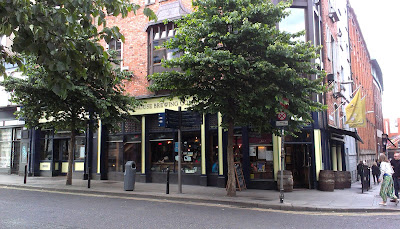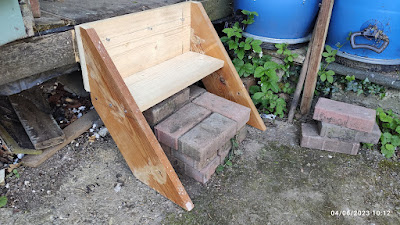The family and I enjoyed a nice and relaxing visit to Yorkshire in order to attend the funeral of Eileen’s aunt. As mentioned previously, Aunt Kathleen was just two months short of her 100th birthday, and her funeral took place last Wednesday. We drove up the day before, with the 250-mile route showing on Google, as taking 4.5 hours. It took considerably longer due to a combination of heavy traffic on the M62 (surely the M25 of the north?), plus arriving in Bradford during the school run rush. This was despite avoiding the city centre and following a ring road of sorts around the periphery. So, plenty of stop starts, and not that much moving forward. Some people do these sort of trips on a regular basis, but a few times a year is more than sufficient for me and if I had my way, I would let the train take the strain. It was a pretty seamless route that we followed though, and with improved section of the A14 northwest of Huntingdon it didn't take long for us to reach the A1. We stopped for lunch at an American-themed roadside restaurant called the OK Diner. This was just to the north of Stamford, a town I would like to visit, but on a more leisurely and less hurried occasion. On the way back we stopped at another OK Diner on the opposite carriageway of the A1. This was a nicer, and much more substantial building, constructed from brick, than its counterpart on the road heading north. We gave Bradford and the M62 a miss on the way home, and instead headed north-east towards the attractive North Yorkshire market town of Knaresborough. This enabled us to pick up the A1, a short distance to the east of the town. Although I had a route outlined in my head, I trusted myself to allow Eileen’s sat nav to guide us. The route chosen avoided Skipton, a town we’d visited on the previous day, before bringing onto the A59 close to Bolton Bridge. We passed through some very pleasant countryside, and after joining the A59, the road began a long and steady climb right back onto the top of the Pennine Moors which looked stunning in the early summer sunshine, but I imagine that particular stretch of road will seem very bleak during winter, and possibly even impassable. We were making good progress, until we reached Ferrybridge, close to the junction with the M62, and here road works, plus associated lane closures, delayed us by at least half an hour. After that we continued southwards, stopping at the full mentioned OK Diner for a well-deserved break plus a very nice burger and fries, before continuing the journey home. Despite hitting the M25 during peak rush hour, the traffic was moving and not too congested, and after crossing the Queen Elizabeth Bridge, we were back in Kent. It's not the sort of return journey I’d want to do on a regular basis, but with good weather and roads which weren't too crowded it wasn't too bad a drive either. All the same I was glad when we pulled onto the drive of Bailey Towers, and I was able to relax for the rest of the evening. I didn't do much in the way of unpacking, although it was considerably more than my good lady wife. I also cracked open a well-deserved, chilled bottle of St Austell Proper Job. It's also worth noting that I bought a selection of eight different bottled beers, all from local Yorkshire breweries. These were purchased from two different ASDA mega-stores, one in Shipley and the other in Keighley. The latter outlet was massive, and as well as offering the same 4 for the price of 3 deal on bottled beers, also had a decent selection of men’s clothing. So, a couple of “T” shirts, plus beers from the likes of Daleside, Ilkley, Ossett, Wharfdale, Salt, York, and Wold Top (Lincolnshire rather than Yorkshire?), I’ve a few new additions to my wardrobe. The bottled beers will make up, in part, for not visiting as many pubs as I would have liked, but with relative to visit and spend time with, plus the funeral itself, there wasn’t a huge amount of time for pubbing. We stayed at a Premier Inn, Mrs PBT’s hotel chain of choice, and their Bingley outlet certainly delivered in terms of comfort and service. I’m more adventurous, but as this trip was mainly about catching up with members from the Yorkshire branch of her family, I left the arrangements to her. My duties were those of chauffeur and travel guide, and on the latter front, we certainly managed to experience some of Yorkshire’s finest and most picturesque locations. Despite the weather forecast warning of an impending heatwave, Saturday's temperatures caught us both by surprise. We didn't surface until after 9:00 AM, and by the time we’d showered, and grabbed some toast for breakfast it was already roasting out on the patio. However, being the stereotypical Englishman who goes out in the midday sun, I stuck it out and enjoyed my toast, marmalade, and coffee. I did take the precaution of wearing a sun hat and smothering myself in sunblock, and this seems to do the trick. I perhaps should then have taken the time to catch up on the blog, but there was food shopping to be done, followed by several tasks to complete outside. I still haven’t finished these, but I probably broke the back of them, including restringing the frame for my runner beans. This morning, I was back in the garden, planting out my runner bean plants that I’d nurtured in the greenhouse. Oh, the joys gardening, but the idea is we’ll have a nice crop of beans to enjoy in the month or so's time, and there’s also some sweet corn seedlings to plant out, once they grow a bit larger.























